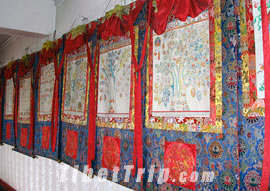 The history of the Tibetan Traditional Hospital can be traced back to 1916. Named Mentsekhang in Tibetan, it began as a regional government teaching organ in which Tibetan doctors and astronomers were trained. In 1959, the government merged Mentsekhang with another medical college, which was formerly situated on the Chakpori Hill. In this way the Tibetan Traditional Hospital and its associated Tibetan medicine factory, were founded. The clinic of the hospital lies in the Barkhor Street , to the west of the Jokhang Temple.
The history of the Tibetan Traditional Hospital can be traced back to 1916. Named Mentsekhang in Tibetan, it began as a regional government teaching organ in which Tibetan doctors and astronomers were trained. In 1959, the government merged Mentsekhang with another medical college, which was formerly situated on the Chakpori Hill. In this way the Tibetan Traditional Hospital and its associated Tibetan medicine factory, were founded. The clinic of the hospital lies in the Barkhor Street , to the west of the Jokhang Temple.Besides the Tibetan people's own experience, the development of Tibetan traditional medical science has a close relationship with Chinese and Indian traditional medical science. The main diagnostic methods Tibetan doctors use today are almost the same as traditional Chinese medicine. In the seventh century, when the Princess Wencheng came to Tibet, she brought a Chinese medical book and Chinese doctors to the Tibetan People. The next Chinese Princess, Jincheng brought another medical book to Tibet and some more doctors as well. In the eighth century, a famous Tibetan doctor, Yutok Yonten Gonpo went to India to study Indian medicine. This knowledge greatly accelerated the development of Tibetan medical science. This doctor learned a lot from Chinese and Indian traditional medical science and incorporated his knowledge into the system of Tibetan medical science.
Numerous Thangkas , hanging on the walls of the hospital, contain the Tibetan medicinal knowledge in all of its aspects, from the beginning of Tibetan medicine, to pictures of human anatomy, to methods of treatments, dietetics, acupuncture and so on. The medical Thangkas depict them with succinct pictures and brief words. This kind of Thangka is an important tool in the teaching of Tibetan medicine.
Tibetan medicine has drawn a great deal of attention from all over the world because of its striking effects on a variety of diseases, such as cranial vascular disease, chronic hepatitis, atrophic gastritis, hypertension, cardiac disease, and cerebral hemorrhage, to name a few. Large numbers of foreign experts and scholars come to Tibet each year to study and investigate Tibetan medicine. Some countries have even introduced Tibetan medicine to their home countries.








